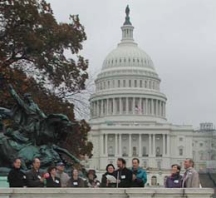Randall
M. Packer
Secretary,
US Department of Art & Technology
Calling
him "a man of great integrity, a man of great judgment and a man who knows
the arts," President George W. Bush announced his decision to nominate
Randall M. Packer to serve as Secretary of the United States Department
of Art and Technology on November 12, 2001. Upon confirmation by the Senate,
Packer pledged to renew the war on cultural poverty, reduce the incidence
of a one-way exchange of information between an active agent and a passive
recipient, and combat discrimination so no American feels outside the field
of aesthetic inquiry of the contemporary media arts.
Packer
began his career as a sound and media artist and founded Zakros InterArts,
a nonprofit arts company originally established in San Francisco. His ability
to work with artists of all disciplines prompted his colleagues in the
nonpartisan interdisciplinary arts to collaborate on seminal productions
of experimental and sometimes confrontational music-theatre. San Francisco
Magazine rated him as "a bright light on the new media horizon - performing
neglected works that fit into no recognizable category," New Media Magazine
described him as exploring "the latest in multimedia wizardry," while Washington
DC's Citypaper credited him with "documenting, inspiring, and exploring
the emergence of a hi-tech utopia."
In
1999, the eve of the new millennium, he moved to the nation's capital to
promote the transformative potential of art and technology, assembling
the "Telematic Manifesto" for ZKM's Net_Condition exhibition, a participatory,
collectively-generated Net Document that articulates a vision for the future
of Telematic Art as a socio-cultural force in the 21st Century." As a media
arts scholar - dedicated to combating cultural poverty, increasing the
quality of media arts education, reducing passive art, and safeguarding
the historical legacy of artists and engineers - Packer co-authored a definitive
text on the history of multimedia, Multimedia: From Wagner to Virtual
Reality. Packer worked closely with colleague Ken Jordan, and an assortment
of theorists, engineers, artists, sociologists, and experts in a myriad
of fields, developing strategies to counter the medium's lack of definition
and context. It was the result of this effort that garnered Packer the
nomination from President Bush as the first Secretary of the US Department
of Art and Technology.
Secretary
Packer is committed to confronting artistic constraints by leading the
US Department of Art & Technology free from conservative aesthetics,
defined by revolutionary practices, and dedicated to upholding the visionary
aspirations of the avant-garde. He will make certain that the Department
fulfills its utopian promise and honors its radical heritage, not only
by articulating the visions of the past, but by supporting the advancement
of all American media artists embracing the integration of art and technology
as the artistic reality of the 21st century.
